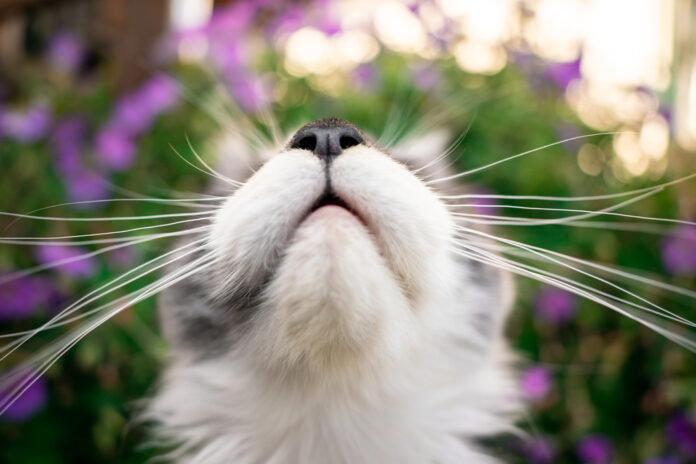What is feline hyperesthesia?
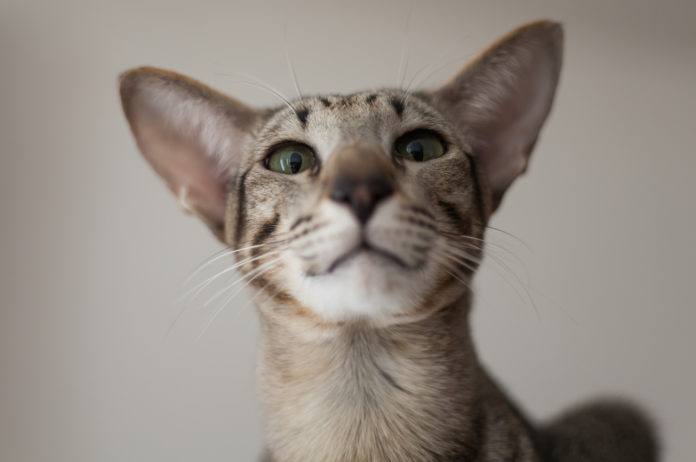
Also called rippling skin syndrome, feline hyperesthesia is an unusual condition that affects cats.
If you have a cat at home, you’re sharing your life with a very distinctive little creature. From their physiology, to their nutritional requirements, to their astonishing physical flexibility, felines are unique among mammal species. Another very unusual thing about cats is their tendency to develop a rather strange disorder called hyperesthesia, which means abnormally increased sensitivity of the skin. This condition is sometimes also referred to as neuritis, atypical neurodermatitis, rippling or rolling skin syndrome, and twitchy cat syndrome.
What are the signs and symptoms?
In cats with hyperesthesia, the skin on the back ripples from the shoulders all the way to the tail, and sometimes right up the tail to the tip. This rippling or rolling movement is clearly visible in some cats, but not all. A more obvious sign is when a kitty suddenly jumps and turn toward her tail as though something back there is bothering her. This can even happen during sleep. The cat might also try to lick or bite at the area. Kitties with hyperesthesia also have muscle spasms and twitches, including tail twitching.
If your cat has this syndrome, he may object when certain areas of his spine or back are touched. He may chase his tail, bite at himself, turn toward his tail and hiss, cry out, run and jump. He may even appear to be hallucinating — following the movement of things that aren’t there — and his pupils may be dilated during these episodes.
What causes hyperesthesia in cats?
No one knows for sure, but there are a lot of possibilities. One of the first things you should do if your kitty is exhibiting the above symptoms is to rule out other causes — for example, flea allergy dermatitis (FAD). In animals with a severe flea allergy, the bite from a single flea can cause long-term itching and skin irritation. FAD can cause your cat to lick and scratch so aggressively — most often at the base of the tail or hindquarters — that she loses a significant amount of fur on that part of her body.
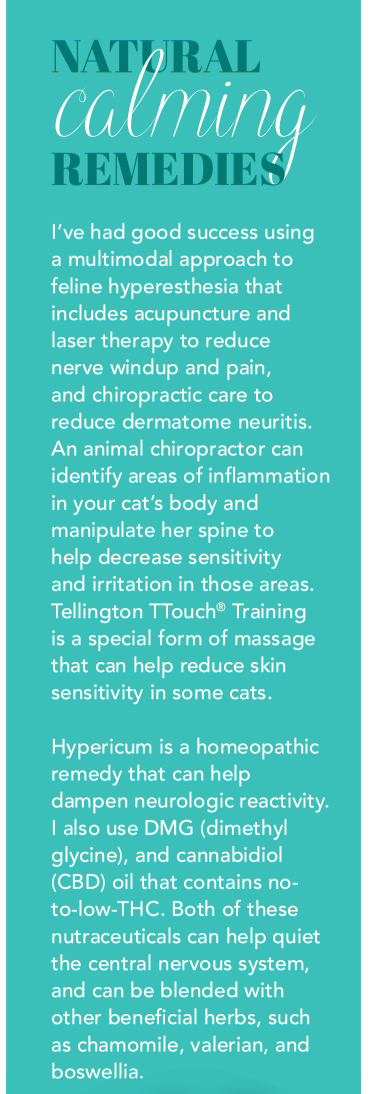 Sometimes dry, itchy skin can induce or aggravate hyperesthesia. Dry skin is typically a sign of Omega-3 fatty acid deficiency, which is common in cats fed poor quality kibble or an unbalanced homemade diet.
Sometimes dry, itchy skin can induce or aggravate hyperesthesia. Dry skin is typically a sign of Omega-3 fatty acid deficiency, which is common in cats fed poor quality kibble or an unbalanced homemade diet.- There’s also a possibility that feline hyperesthesia is related to a seizure disorder. Some kitties experience grand mal seizures during or right after episodes of hyperesthesia. Some experts think the syndrome could be caused by a problem with electrical activity in areas of the brain that control grooming, emotions, and predatory behavior.
- The syndrome may also be a form of obsessive-compulsive disorder, with the obsession being fearfulness, grooming, and/or aggression. Seizure activity is known to lead to obsessive-compulsive behavior.
- Since I’ve found chiropractic to be one of the best ways to treat this strange condition, an underlying neuromuscular disorder should also be considered. It is conceivable that hyperesthesia is a combination of electrical-neurological, musculoskeletal, and behavioral issues.
- Finally, cats with this condition have been found to have lesions in the muscles of their spine. It’s possible the lesions cause or contribute to the sensations and symptoms that are a feature of hyperesthesia.
How can hyperesthesia be treated?
Feline hyperesthesia is a diagnosis of exclusion, meaning it’s the only option left after eliminating other conditions and diseases that cause similar symptoms and behavior. If possible, get a video of your cat during an episode of what you suspect is hyperesthesia, and take it with you to your veterinary appointment.
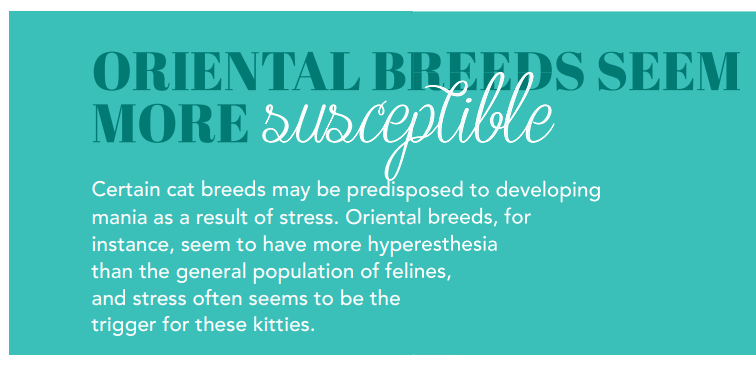
The treatment for feline hyperesthesia syndrome involves reducing your cat’s stress level.
- Diet is the first place I always start, because the wrong foods create physiologic and metabolic stress.
- Ideally, your cat should be eating a species-specific, nutritionally optimal fresh food diet that contains no high-glycemic carbohydrates. By eliminating ultra-processed cat food and switching to fresher, less heat-processed food, you also minimize the level of toxic Maillard Reaction Products (MRPs) your cat consumes. MRPs occur whenever protein (amino acids) and starch (carbs) are heated, creating detrimental chemical by-products in the food that create massive inflammation in your cat’s body when consumed. The higher the heat, and the more times food is heated, the more MRPs are present. MRPs have been linked to many neurologic disorders in humans.
- The least metabolically stressful diet for cats should include moderate amounts of animal fat and a high percentage of fresh, whole animal protein. Feeding a variety of different proteins is important for nutritional diversity, and reduces the risk your cat will become sensitive to a particular food. I’ve seen food allergies, specifically sensitivities to poultry or seafood, trigger kitties with hyperesthesia.
- I would also recommend eliminating all chemical preservatives from the diet. A diet that contains no GMOs, dyes, synthetics or other additives is best.
2. Consider adding an Omega-3 fatty acid supplement and curcumin to reduce inflammation in your cat’s body.
3. I also recommend purified drinking water from non-plastic bowls; non-toxic cleaning products inside your home; and no smoking of any kind near your cat.
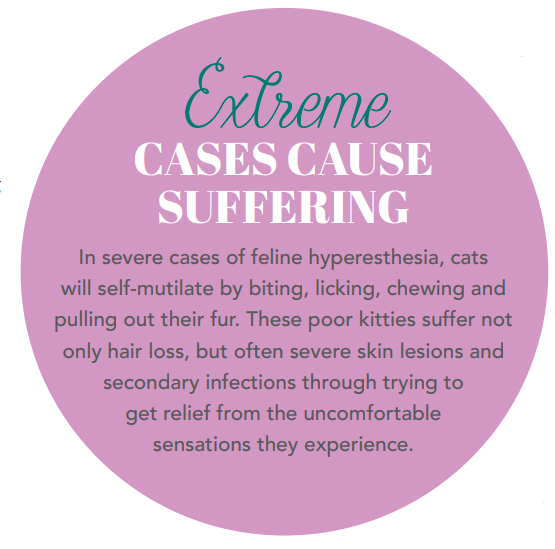 Many veterinarians immediately recommend drug therapy for hyperesthesia patients. In my opinion, giving your cat antidepressants, anticonvulsants, or other drugs to curb obsessive behavior should be options of last resort, although low-dose naltrexone can be of benefit. An optimal diet along with environmental enrichment and natural calming remedies (see sidebar) can be tremendously beneficial in alleviating the stressors in your cat’s life that tend to trigger episodes of hyperesthesia.
Many veterinarians immediately recommend drug therapy for hyperesthesia patients. In my opinion, giving your cat antidepressants, anticonvulsants, or other drugs to curb obsessive behavior should be options of last resort, although low-dose naltrexone can be of benefit. An optimal diet along with environmental enrichment and natural calming remedies (see sidebar) can be tremendously beneficial in alleviating the stressors in your cat’s life that tend to trigger episodes of hyperesthesia.
While feline hyperesthesia is a very strange syndrome, there are many ways to help alleviate it, so your cat can feel more comfortable in his own skin again.



